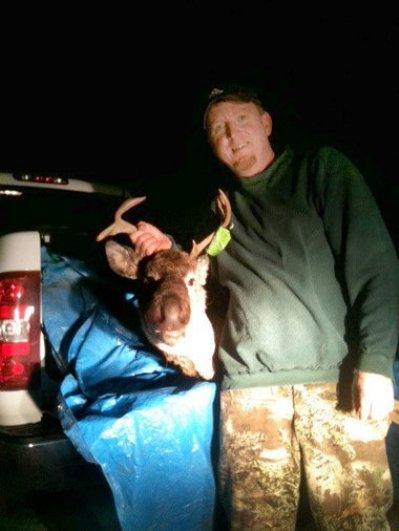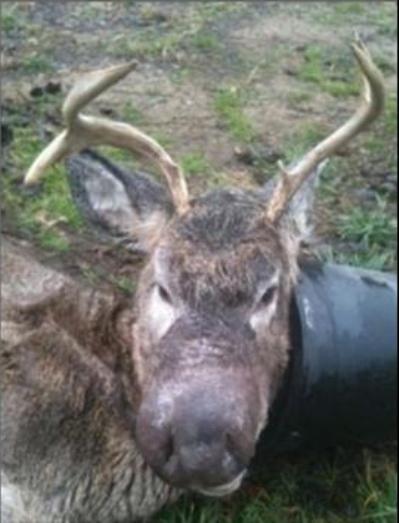LAST UPDATED: May 1st, 2015
Michigan hunter Dale Wallace had been capturing trailcamera photos of a bizarre buck all summer long. At first, Wallace thought the swollen nose was caused by a bee sting or some other injury, but when he ended up harvesting the buck earlier this December he was surprised to find the buck’s nose still malformed and immediately looked for answers.
Wallace first notified Michigan Department of Natural Resources (MDNR) workers at a deer check station about the unusual size of the buck’s nose, but they seemed uninterested. With convincing from his wife, he sent the photos to a popular deer hunting website in hopes of receiving an answer to the abnormality.
Hunter Dale Wallace poses with his unusual trophy.
A few days later he was contacted by Georgia wildlife pathologist, Kevin Keel. After a long conversation Keel convinced Wallace to ship the head down to the Southeastern Cooperative Wildlife Disease Study at the University of Georgia where it could be further studied. The University of Georgia group has studied thousands of diseased deer since 1957, including about 10 animals with the same ailment from across the country.
Keel believes the buck’s unusual ailment is caused by a chronic bacterial infection that produces an abnormal accumulation of connective tissue underneath the skin. In a recent interview with the Kalamazoo Gazette, Keel stated, “I am currently trying to determine what type of bacteria might be responsible. Previously, the bacteriology lab has been unsuccessful in getting the species of bacteria present to grow. I am going to try to use genetic methods to determine what it might be. Once we have some idea of what we are dealing with, if it is similar to known bacteria, we may be able to tailor culture conditions to better suit it.”
Keel believes hunters and wildlife lovers should not be in fear of the rare ailment – further explaining, “Deer may be coming in contact with something that they weren’t exposed to previously due to alterations in their habits. Or perhaps there is some factor that is predisposing them to infection by a species of bacteria that is common in the environment. With so few cases we may never fully understand what is causing it.”
Hoping to help out Keel and MDNR wildlife biologist/pathologist, Thomas Cooley, who later took interest in the buck, Wallace explained that the processor found unusual discolored rings under the hide. The hide itself, he explained, also had a very tough white tissue connecting it to the body.
Wallace also observed that in every trailcamera image he captured of the buck, it was always alone, as if the other deer wanted nothing to do with it.
Wallace is currently waiting for the tests to come back on the buck he took. In the meantime, his taxidermist is trying to find a mannequin that will fit the buck’s unusual hide.







